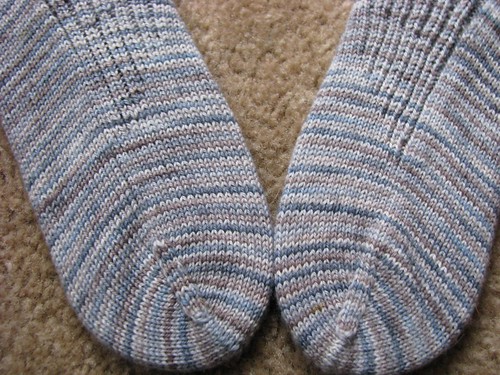Note from the SpaceCadet: My friend Abigail of TAAT Designs is a wonderful knitter and real connoisseur of hand-dyed yarns. And I am delighted that she agreed to share how she chooses the right pattern for each unique yarn…
.
By Abigail
In a recent post on my blog, I was reflecting on my relationship with yarn and I realized that it’s not just about the yarn, but also about the potential contained within it. When I see a skein of yarn, I see more than just the yarn itself. I see the twist of the yarn, the way the colors blend together and how the fiber appears. From here, however, it’s not always straightforward to picture what the yarn will look like when it is knit up, which makes it hard to choose a pattern. Especially with handpainted yarns, there’s always a bit of uncertainty. How long is each bit of color? Do the colors repeat in a systematic manner, or are they completely random? With experience, it becomes easier to predict these things without knitting a swatch, but even a prediction is still no guarantee of what the finished product will look like.
Most handpainted yarns do have a predictable repeat. This means that they will tend toward pooling or striping, depending on the length of each stretch of color. The best way I have found to determine this is to unwind a length of the yarn – two yards is usually enough. If the entire length is all one color, then the yarn will stripe in many usages (socks, children’s sweaters, hats, mittens – anything that is less than about 2 feet in circumference or width). If the length is multiple colors, then you can try to predict whether it will stripe or not by estimating how many stitches you can get out of each color section (a good rule of thumb is that it takes 3x as much yarn as the length of fabric you are knitting across).
Once you know roughly whether the yarn will stripe or not, it becomes easier to choose a pattern. My preference is for yarns that do not stripe, or have minimal striping – I like a new color in every row of my knitting. I’m also a big fan of knitting socks with handpainted yarns, so that’s usually where my mind first goes.
When I received my skein of SpaceCadet Creations’ Cold Waters earlier this year, I wasn’t sure at first what it wanted to be. The colors were so subtle and yet striking all at once, and I wanted to choose a pattern that would really show off the colors. From looking at the yarn, I was able to predict that it would stripe slightly, but not be too overpowering. There was also not much chance of pooling (which I do my best to avoid). This told me that I didn’t need to choose a pattern that would actively reduce pooling, but I didn’t want to choose a pattern that was too busy, either, so that I didn’t overpower the yarn. Because Cold Waters uses tonal shading rather than lots of different colors, however, I knew the pattern could have a little something going on.
The stockinette portion of the sock clearly shows the beautiful, subtle, not-quite-single-row striping of Cold Waters.
Around the time I received my Cold Waters, I also received a gorgeous pattern from Yarnissima (through a monthly sock yarn club I belong to), The Portland Gussets. I had been looking for the perfect yarn for this pattern, and Cold Waters seemed like it would fit. It had everything I was looking for: medium-length color repeats (too short, and the pattern would be lost in the yarn), not too much color variation (any more, and the yarn would obscure the pattern), but enough visual interest (not enough, and the pattern would be boring).
I quickly cast on, and the socks just flew off my needles. The pattern and yarn were a great fit!
When you’re knitting hand-dyed yarns, each skein is a unique adventure. With a little practice, it becomes easy to match a yarn to pattern. If you take the time to examine the yarn and read its color repeat, the yarn will help you decide which pattern to choose for it.
TAAT Designs is a newly formed design group created by four friends — Trisha, Allison, Abigail and Tesia — to combine their love of knitting with their desire to create unique and fun patterns for knitted objects of all types. Read more about their adventures on the TAAT Designs blog.







